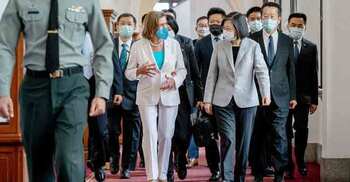Beijing responds to Pelosi visit with days of military drills encircling Taiwan

Beijing is ramping up its military intimidation campaign against Taiwan with days of drills to be held around the self-ruled island in the wake of a visit by US House Speaker Nancy Pelosi.
The People’s Liberation Army said the exercises would take place in six different areas around Taiwan from Thursday to Sunday.
Foreign airlines have been told to avoid these “danger zones” during the period, in notices sent by Chinese aviation authorities. Representatives of Korean Air, ANA and Japan Airlines said they were re-routing some services to minimise the risk, Bloomberg reported. Xiamen Airlines has also made changes to flights, citing “flow control” in the mainland Chinese province of Fujian, which is opposite Taiwan.
It comes after the PLA’s Eastern Theatre Command conducted air and sea drills near the island that began on Tuesday evening, when Pelosi arrived in Taipei for a brief visit that has infuriated Beijing, which sees the island as part of its territory and has not ruled out the use of force to take control of it.
It comes after the PLA’s Eastern Theatre Command conducted air and sea drills near the island that began on Tuesday evening, when Pelosi arrived in Taipei for a brief visit that has infuriated Beijing, which sees the island as part of its territory and has not ruled out the use of force to take control of it.
The drills continued on Wednesday “over airspace in northern, northwestern and southeastern parts of Taiwan”, according to an Eastern Theatre Command statement that included a photo of a J-20 stealth fighter jet taking part.
It said they aimed to “rehearse a coordinated blockade, anti-naval and army attacks, and air combat to test joint fighting capabilities”.
Taiwanese Transport Minister Wang Kwo-tsai said the island’s officials were talking to counterparts in Japan and the Philippines to arrange alternative air routes.
“Our assessment is that the impact [of the drills] will not be severe but flight times are likely to be longer,” Wang told reporters on Wednesday.
Military analysts say the drills – which are expected to include missile tests – are aimed at making sure the Taiwanese public know about them.
“[Imagine] the public panic when 23 million Taiwanese people all get a text message alert on their mobile phones from the government’s missile warning system,” said Lu Li-shih, a former instructor at Taiwan’s Naval Academy in Kaohsiung.
Fu Qianshao, a retired air force armament expert in Beijing, said the drills across six locations would blockade the island.
“The drills will encircle Taiwan – especially its main ports [Keelung and Kaohsiung] – meaning that ships won’t be able to leave and foreign vessels, including civilian transport vessels, won’t be able to enter,” he said.
“Some of the areas are within [what Taiwan sees as its] territorial waters, so this will be to show that Taiwan is part of China.”
A map showing the six locations was published by Chinese state media following the PLA announcement, with a live-fire exercise to be held across the median line that divides the Taiwan Strait and a missile test in waters off the island’s eastern coast.
Andrei Chang, editor-in-chief of the Canada-based Kanwa Asian Defence Monthly, expected the drills to be “much larger and more complicated” than during the Taiwan Strait crisis from 1995 to 1996.
Beijing conducted missile tests that landed near Taiwan after the island’s first democratically elected president, Lee Teng-hui, visited the US in 1995.
“This time, the mainland is supported by the home-grown BeiDou Navigation Satellite System and can more precisely land missiles,” Chang said.
He said the PLA could carry out more such drills encircling Taiwan in the future, adding to pressure on the island’s military and increasing the risk of an accidental conflict. “The PLA wouldn’t have direct conflict with their American counterparts as the two militaries have communication channels, but there’s nothing with the Taiwanese,” Chang said.
According to Lu, the drills also aimed to expose Taiwan’s defence vulnerabilities. “Beijing wants to flex its muscles and expose the weaknesses of Taiwan’s defence system, sending a message that it can defeat the island,” he said.
Ni Lexiong, a military analyst at the Shanghai University of Political Science and Law, said the J-20 fighter jets would have been deployed for the earlier drills “in response to Taiwan’s new F-16V fleet – a tailor-made version from the US to match the J-20 in any possible contingency”.
“The PLA wants to remind their Taiwanese counterparts that the mainland has air superiority, and that’s a very different situation compared with previous crises across the Taiwan Strait,” he added.
Taipei ordered 66 F-16Vs from the US two years ago and is expected to have a complete fleet by 2026. It is an upgraded version of the Taiwanese air force’s outdated F-16A/B and is equipped with an APG-83 active electronically scanned array radar and other avionics that enable it to better detect and match the PLA’s J-20.
Source: South China Morning Post





